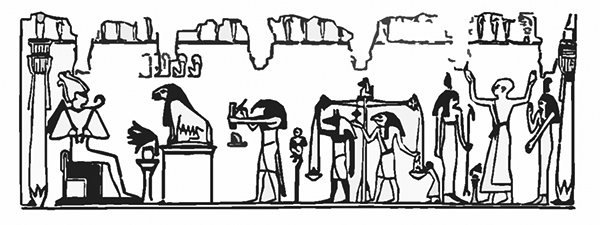Within the simple and easily formulated problem asked in the heading is contained the sublimest of all secrets, which several of the higher degrees have sought to answer, each in its own way. It involves the intimate application of all the symbolic degrees to the initiate himself, without which they are as empty as air.
In all the ancient mysteries a character was assumed by the candidate, and as the candidates were many and the character depicted always the same, it must have represented something essentially common to all alike. Furthermore, the precise similarity of the experiences to which each individual candidate was subjected argued the identical lesson in all cases.

The trial of the Dead
Examination of all available detail, especially the sacred writings of many races, confirms us in the conviction that this universal character was but an allegorical representation of the Ego or “self,” engaged in the warfare of which it has been said that the victor is “greater than he who taketh a city” and emerging a conqueror in the very instant of apparent defeat. We receive our earliest concrete presentation of such a character in the celebrated document known as the Egyptian Book of the Dead, the Bible of the builders of the Pyramids, fragments of which are found wrapped in the cloths of almost every mummy.
The Book of the Dead presents the wanderings of a departed soul through the underworld to the council of the gods, who were to listen to its accusers, give heed to its defenders, and finally weigh its accumulated good deeds in the scales against the feather symbol of “truth.” The name of this character is given as Ani the Scribe. It finally transpired that this name was equivalent to the Latin term ego, meaning the “I Am” or “self” in man. This leads to what was perhaps the greatest and most important of all secret teachings of the ancient world, one that has become so obscured by the confusion of its many dramatic representations with real historical characters,-that most clear and careful labor is required to trace the main ideas from age to age and people to people, in order to show that they are fundamentally, everywhere, exactly the same.
There is no difficulty whatever in recognizing the self-conscious principle in every man as being an actual spark of the infinite self-consciousness precipitated into material existence, through the labyrinth of which it is compelled to strive in ceaseless search for the Master’s Word, the secret of its being and immortal destiny. If this idea of the struggle of a divine and immortal soul, weighed down with the burden of matter and assailed at every turn by foes that symbolize the continual transformations of matter from `life” to “death” and “death” to “life,” be taken as the vital principle of every drama of regeneration, from the “Book of the Dead” to John Bunyan’s “Pilgrim’s Progress,” we too shall have progressed a long way upon the road to understanding, that of Freemasonry.
The beautiful star that is the chief emblem of the Royal Arch degree, besides being the sacred symbol of Israel, has had no other meaning during the thousands of years from the most ancient Brahmanism to the Temple of today . Even when called “the United Seal of Vishnu and Siva,” the “Immortal” and the “Mortal,” or “Fire” the symbol of Spirit, and “Water” the symbol of Matter, it represented the same idea, that of the “Self Conqueror,” the Perfect Man, who had learned the subjugation of human passions and perfection in attitude toward God and fellow man. Thus the up-pointing triangle stood for the ascent of matter into spirit which is typified by the phrase “resurrection of the body,” and the down-pointing triangle the descent of spirit into matter, and the complete star represents the immortal being fitted to dwell in “that house not built with hands, eternal in the heavens.”
Contents – The Beginning of Masonry
Previous – The Candidate
Next – The Widow’s Son
